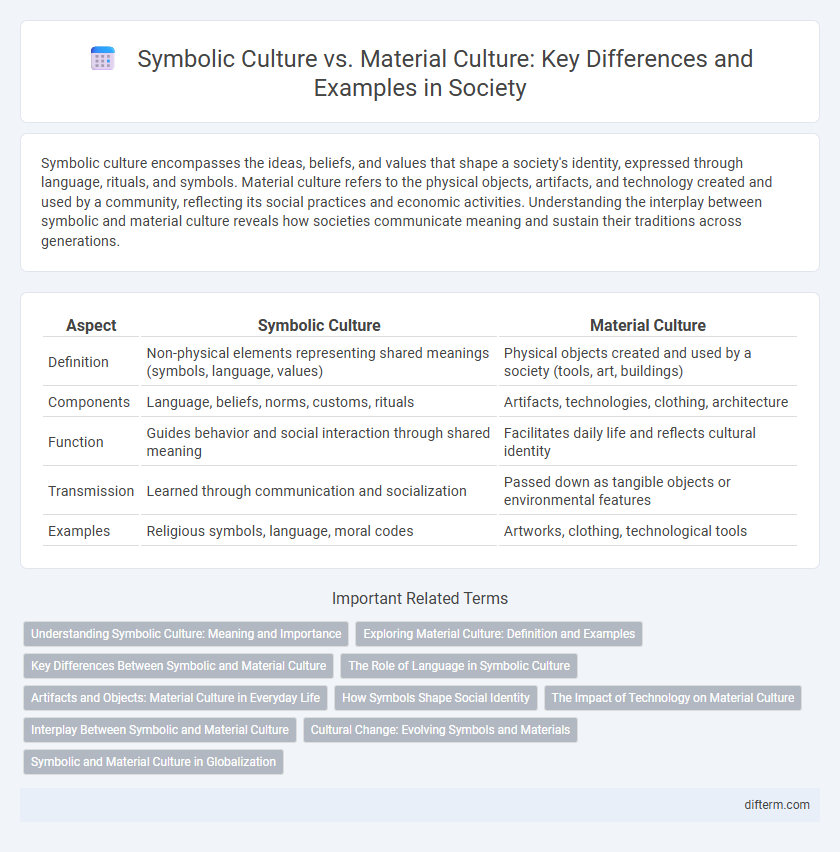Symbolic culture encompasses the ideas, beliefs, and values that shape a society's identity, expressed through language, rituals, and symbols. Material culture refers to the physical objects, artifacts, and technology created and used by a community, reflecting its social practices and economic activities. Understanding the interplay between symbolic and material culture reveals how societies communicate meaning and sustain their traditions across generations.
Table of Comparison
| Aspect | Symbolic Culture | Material Culture |
|---|---|---|
| Definition | Non-physical elements representing shared meanings (symbols, language, values) | Physical objects created and used by a society (tools, art, buildings) |
| Components | Language, beliefs, norms, customs, rituals | Artifacts, technologies, clothing, architecture |
| Function | Guides behavior and social interaction through shared meaning | Facilitates daily life and reflects cultural identity |
| Transmission | Learned through communication and socialization | Passed down as tangible objects or environmental features |
| Examples | Religious symbols, language, moral codes | Artworks, clothing, technological tools |
Understanding Symbolic Culture: Meaning and Importance
Symbolic culture encompasses the intangible elements of culture, such as language, beliefs, values, and norms, that shape social interactions and collective identity. It provides the framework through which individuals interpret symbols, rituals, and traditions, enabling cohesive communication and shared meaning within a society. Understanding symbolic culture is crucial for analyzing how cultural meanings influence behavior and sustain social continuity beyond physical artifacts found in material culture.
Exploring Material Culture: Definition and Examples
Material culture encompasses the physical objects, resources, and spaces that people use to define their culture, including tools, clothing, buildings, and artwork. These tangible items serve as concrete expressions of cultural values, beliefs, and social structures, reflecting historical context and technological advancements. Examples of material culture range from ancient pottery and architectural monuments to modern technology and fashion, illustrating the evolving relationship between people and their environment.
Key Differences Between Symbolic and Material Culture
Symbolic culture encompasses intangible elements like beliefs, values, language, and norms that shape a society's identity and guide behavior, while material culture consists of physical objects, artifacts, and technology created and used by people. Key differences include the fact that symbolic culture influences the meaning and interpretation of objects within material culture, whereas material culture provides tangible evidence of cultural practices. Understanding these distinctions helps analyze how cultural expressions evolve through both ideas and artifacts across time and societies.
The Role of Language in Symbolic Culture
Language functions as a core component of symbolic culture, enabling the transmission of values, beliefs, and norms through shared symbols and meanings. It shapes social reality by allowing individuals to construct and interpret cultural narratives, fostering group identity and cohesion. Unlike material culture, which consists of tangible objects, language provides an intangible framework for understanding and communicating cultural experiences.
Artifacts and Objects: Material Culture in Everyday Life
Artifacts and objects embody material culture by providing tangible expressions of a society's values, beliefs, and technological advancements. Everyday items like clothing, tools, and artwork serve as physical evidence of cultural practices and social norms, revealing the material conditions of a community. These material objects act as mediums through which symbolic meanings are communicated, preserving cultural identity across generations.
How Symbols Shape Social Identity
Symbols in symbolic culture serve as powerful tools for communicating social identity, enabling individuals to express belonging, values, and group membership through language, gestures, and rituals. Unlike material culture, which includes tangible objects like clothing and artifacts, symbolic culture centers on intangible elements such as beliefs, norms, and symbols that convey meaning beyond physical form. These symbols anchor social identity by creating shared understanding and cohesion within communities, guiding behavior and reinforcing cultural continuity across generations.
The Impact of Technology on Material Culture
Technology significantly shapes material culture by transforming the physical objects people create, use, and value, from traditional tools to advanced digital devices. Innovations like 3D printing and smart technologies redefine craftsmanship, manufacturing, and consumption patterns, influencing societal behaviors and economic structures. This evolution in material culture reflects shifting cultural priorities and impacts identity, communication, and interaction in contemporary societies.
Interplay Between Symbolic and Material Culture
Symbolic culture encompasses the ideas, beliefs, language, and values that shape societal norms, while material culture involves the tangible objects and artifacts created and used by a society. The interplay between symbolic and material culture is evident as symbols influence the creation and use of material goods, and in turn, these material objects reinforce or transform cultural meanings and social practices. This dynamic relationship shapes identity, communication, and continuity within cultures over time.
Cultural Change: Evolving Symbols and Materials
Symbolic culture consists of intangible elements like language, beliefs, and values that shape social behavior, while material culture includes physical objects such as tools, clothing, and art. Cultural change occurs when new symbols emerge or existing ones evolve, influencing collective identity and communication patterns. Simultaneously, advancements in technology and shifts in societal needs transform material culture, reflecting and reinforcing these symbolic modifications over time.
Symbolic and Material Culture in Globalization
Symbolic culture encompasses the ideas, beliefs, values, and language that shape societal norms across global communities, influencing identity and social cohesion. Material culture refers to the physical objects, artifacts, and technology that people create and use, reflecting economic development and technological exchange worldwide. In globalization, symbolic culture spreads through media and communication, while material culture facilitates cultural interaction and economic integration across borders.
symbolic culture vs material culture Infographic

 difterm.com
difterm.com